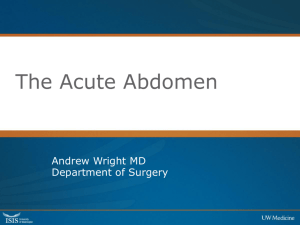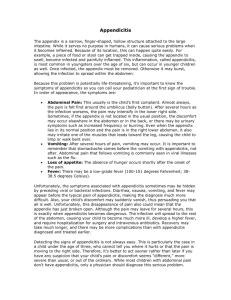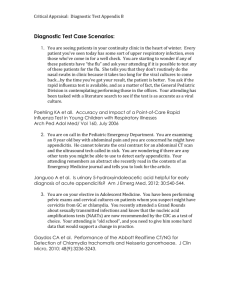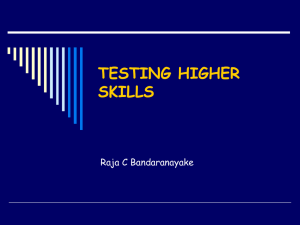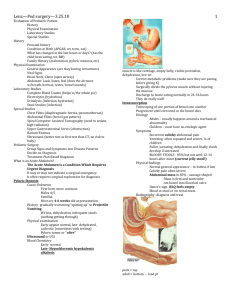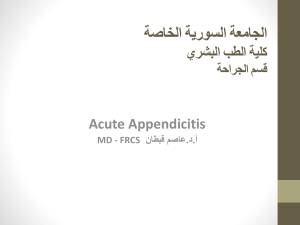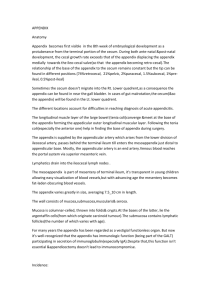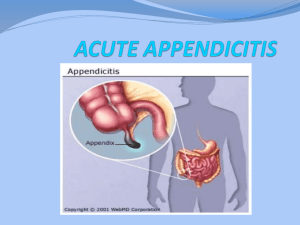Tis The Season.
advertisement
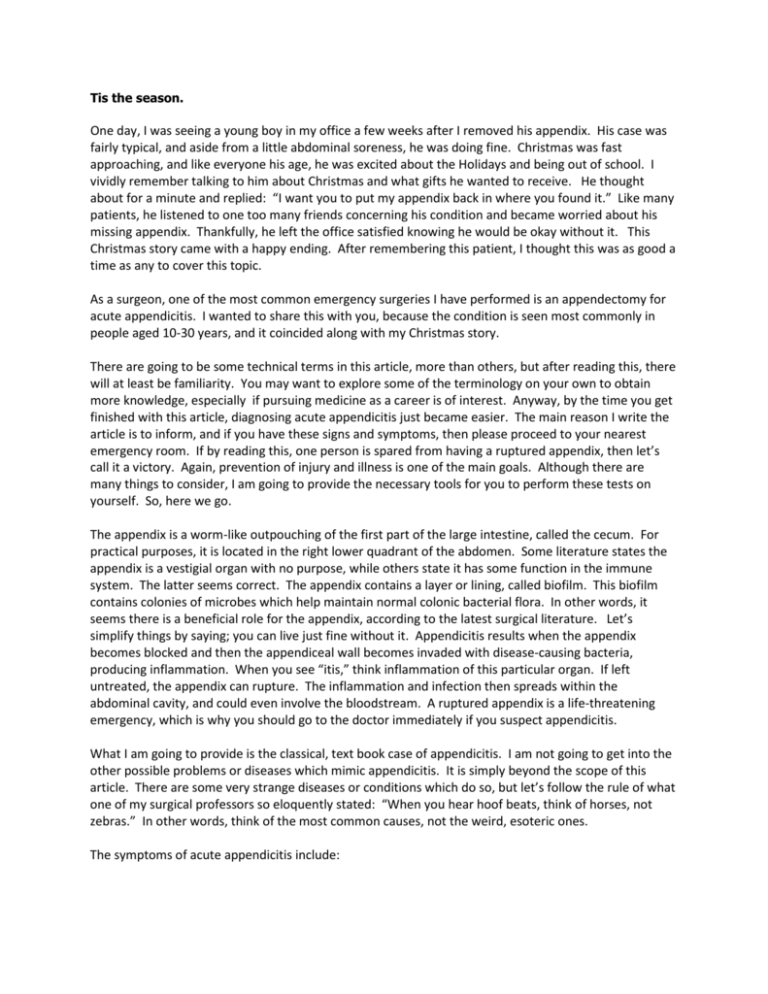
Tis the season. One day, I was seeing a young boy in my office a few weeks after I removed his appendix. His case was fairly typical, and aside from a little abdominal soreness, he was doing fine. Christmas was fast approaching, and like everyone his age, he was excited about the Holidays and being out of school. I vividly remember talking to him about Christmas and what gifts he wanted to receive. He thought about for a minute and replied: “I want you to put my appendix back in where you found it.” Like many patients, he listened to one too many friends concerning his condition and became worried about his missing appendix. Thankfully, he left the office satisfied knowing he would be okay without it. This Christmas story came with a happy ending. After remembering this patient, I thought this was as good a time as any to cover this topic. As a surgeon, one of the most common emergency surgeries I have performed is an appendectomy for acute appendicitis. I wanted to share this with you, because the condition is seen most commonly in people aged 10-30 years, and it coincided along with my Christmas story. There are going to be some technical terms in this article, more than others, but after reading this, there will at least be familiarity. You may want to explore some of the terminology on your own to obtain more knowledge, especially if pursuing medicine as a career is of interest. Anyway, by the time you get finished with this article, diagnosing acute appendicitis just became easier. The main reason I write the article is to inform, and if you have these signs and symptoms, then please proceed to your nearest emergency room. If by reading this, one person is spared from having a ruptured appendix, then let’s call it a victory. Again, prevention of injury and illness is one of the main goals. Although there are many things to consider, I am going to provide the necessary tools for you to perform these tests on yourself. So, here we go. The appendix is a worm-like outpouching of the first part of the large intestine, called the cecum. For practical purposes, it is located in the right lower quadrant of the abdomen. Some literature states the appendix is a vestigial organ with no purpose, while others state it has some function in the immune system. The latter seems correct. The appendix contains a layer or lining, called biofilm. This biofilm contains colonies of microbes which help maintain normal colonic bacterial flora. In other words, it seems there is a beneficial role for the appendix, according to the latest surgical literature. Let’s simplify things by saying; you can live just fine without it. Appendicitis results when the appendix becomes blocked and then the appendiceal wall becomes invaded with disease-causing bacteria, producing inflammation. When you see “itis,” think inflammation of this particular organ. If left untreated, the appendix can rupture. The inflammation and infection then spreads within the abdominal cavity, and could even involve the bloodstream. A ruptured appendix is a life-threatening emergency, which is why you should go to the doctor immediately if you suspect appendicitis. What I am going to provide is the classical, text book case of appendicitis. I am not going to get into the other possible problems or diseases which mimic appendicitis. It is simply beyond the scope of this article. There are some very strange diseases or conditions which do so, but let’s follow the rule of what one of my surgical professors so eloquently stated: “When you hear hoof beats, think of horses, not zebras.” In other words, think of the most common causes, not the weird, esoteric ones. The symptoms of acute appendicitis include: Dull, aching pain beginning in the peri-umbilical region, (navel, belly button). It usually localizes to the right lower quadrant of the abdomen within 12-24 hours. Fever-usually, low grade, temperatures ranging from 99-101 degrees Fahrenheit Loss of appetite Nausea, vomiting, diarrhea, constipation There are many other things to consider, but these give you a good start to recognizing the potential problem. Now, let’s get to some terms I want you to know. Supine Position-lying face up, on your back Peritoneum-This is the covering, or lining of the abdomen and contained organs. It is a serous membrane which lines the abdominal cavity, supports the abdominal organs, and serves as a conduit for their blood/lymphatic vessels, and nerves. Think of a piece of clear, plastic kitchen wrap used to cover foods. Anterior Superior Iliac Spine (ASIS)-This is an anatomical landmark which is part of the iliac crest of the pelvis. It is a bony structure you feel on your right side when you are lying on your back. Palpate, or Palpation- to apply touch, feel, or pressure with your hands during a physical examination Now, Doctor, here are the signs associated with acute appendicitis, and you can perform these tests on yourself. All are performed in the Supine Position, unless otherwise specified. I am not going to mention them all, but I am going to demonstrate the most common ones performed. Guarding: This refers to the tensing of muscles in response to touch. Think of it this way: If you are in pain, you don’t want anyone touching the affected area, because it hurts. Press firmly over the right lower quadrant in the abdomen. In response to palpation, you guard the area. Should you be guarding the area, it is a suspicious sign. McBurney’s Sign-This is named after the surgeon who first discovered it. Guess what his name was. You got it: Mc Burney. Now, we talk about McBurney’s point as an anatomical landmark. This is the name given to the area on the right side of the abdomen 1/3 the distance from the ASIS to the navel. It roughly corresponds to the most common location of the appendix. If while palpating McBurney’s Point, tenderness is experienced; then you have a positive McBurney’s Sign. Look for pain and tenderness over McBurney’s Point which is suspicious for acute appendicitis. Rovsing’s Sign-This also is named for another surgeon. You are right: Rovsing. Here, you press on the LEFT lower quadrant of your abdomen. When you do, there is pain on the RIGHT side of your abdomen. Obturator Sign-This is due to irritation of the Obturator Internus Muscle. The right knee is flexed to 90 degrees. Then, rotate the leg both toward and away from your body. This hip/knee flexion, coupled with internal/external rotation is the test. If abdominal pain results, then you have a positive Obturator Sign. Psoas Sign-This is in regards to the Psoas muscle, which is part of the Ilio Psoas group of hip flexor muscles located deep within your body. The “P” in Psoas is silent, by the way. This is pronounced “So As.” This test involves you lying supine on a bed or couch. The bed is preferable, because you want the leg to really stretch toward the floor. Simply drop your right leg off the bed, obtain a good stretch, and see if this produces abdominal pain. If so, it is a positive sign. Peritoneal Sign-This indicates inflammation and irritation of the peritoneum. Now, things are getting serious, should this be positive. This is indicative of peritonitis, and punches your ticket to the operating room. Press firmly over McBurney’s Point. Now, quickly remove your hand. If it hurts more when you let go than it did when you were pressing down on the abdomen, then this is a positive Peritoneal Sign. It is also called “Rebound Tenderness.” Again, this means surgery is most likely in your future. Another way to test for peritoneal signs is to simply jump up and down. If this reproduces your pain in the right lower quadrant, then this is also a positive test. Additionally, if you are riding in a car and are jarred by a bump in the road, such as a speed bump, and abdominal pain results, this is a positive test, as well. Think of it this way: When patients hurt, they usually want to lie down in the their beds, quiet, still, and undisturbed. These tests for Peritonitis disturb them. Should you have any of these signs and symptoms, please tell your parents. Please know; every time you have a stomach ache does not mean you have appendicitis. As I said, there are many causes, the most common would be a viral gastroenteritis or food poisoning, as examples. However, now you are at least familiar with the most common findings seen associated with acute appendicitis. It is also very important you don’t take antibiotics or pain pills if you suspect you have this problem. The reason why is because their use can “mask” or cover up the signs and symptoms your doctor uses to help make the diagnosis. If you experience these things mentioned in this article, also, please do not eat or drink ANYTHING before you go to the emergency room. This is because food or drink in your stomach may cause life-threatening problems related to your general anesthesia, or being put to sleep for your operation. Another thing is not delay the inevitable. If you have these problems, don’t wait for hours to report them to someone or visit your doctor. A delay in diagnosis can lead to a ruptured appendix, which is an entirely different, more severe problem. You can expect these tests to be performed during your physical examination. You can also expect a test on your blood and urine. Sometimes, if the tests are unclear for any reason, your doctor may order a CAT Scan or Ultrasound of the abdomen, too. Now, you have knowledge about your appendix and acute appendicitis. Remember, if you experience any of these problems, please tell your parents, so they can get you to the Emergency Room. Also, if you have surgery, you must know protein requirements are increased during the post-operative phase. Eating extra protein boosts the immune system, helps build a stronger scar, and is a vital component for healing. As I surgeon, I realize this, because I see it every day. This is one of the main reasons I created Pro Bites protein snacks. Pro Bites have been very successfully clinically tested among patients who need extra protein to heal and return to wellness. Thank you. Merry Christmas and a Happy New Year! Let’s commit ourselves to great health in this coming year. Dr. Steve Dr. Steven L. Snodgrass, M.D., F.A.C.S. is a former Chief of Surgery, member of the American Medical Association, Fellow of the American College of Surgeons, father of two athletic sons, and the son of a cancer survivor. Because of his experiences, he created a healthy protein snack to help both athletes and patients meet their specific needs. His new product, Nutri Snax will be available, soon. A portion of sales proceeds will be used to support The Minnie Pearl Cancer Foundation. For more information visit www.minniepearl.org

